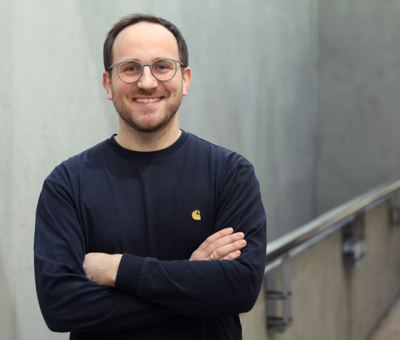Diffusion processes in ground rubber containing compounds
Stefan Frosch is a PhD student in the Department Diffusion processes in ground rubber containing compounds. (Co)Promotors are prof.dr. A. Blume and dr. F. Grunert from the Faculty of Engineering Technology and prof.dr. V. Herrmann from the Technical University of Applied Sciences Würzburg-Schweinfurt.
 The recycling of end-of-life rubber materials such as tires is becoming increasingly important in terms of sustainability and the circular economy. One form of rubber recycling is the processing of vulcanizates into ground rubber (GR) with diameters between 0.2 and 2 mm. These particles can then be incorporated into new compounds, which reduces the required amount of virgin material.
The recycling of end-of-life rubber materials such as tires is becoming increasingly important in terms of sustainability and the circular economy. One form of rubber recycling is the processing of vulcanizates into ground rubber (GR) with diameters between 0.2 and 2 mm. These particles can then be incorporated into new compounds, which reduces the required amount of virgin material.
Foto: Sophia Krotter/THWS
However, the in-rubber properties of these vulcanizates deteriorate compared to those that do not contain GR. The main reason for this deterioration is the diffusion of sulfur from the surrounding rubber matrix into the GR particles. The sulfur influences the properties of the vulcanizates by forming crosslinks between the polymer chains. If the sulfur concentration in the matrix is reduced by diffusion, the number of crosslinks is also lowered and hence the in-rubber properties of the vulcanizate are deteriorated.
In this thesis, these processes are investigated in more detail to find a solution for a reduction of the described sulfur diffusion and thus a minimization of the in-rubber property deterioration. Using spatially resolved measurement methods such as Micro X-Ray Fluorescence analysis (µ-XRF) or the Micro Dynamic-Mechanical Indentation method (µ-DMI), sulfur diffusion and property changes are quantified locally in the matrix and in the GR particles. It is also shown that the diffusion between GR and matrix is significantly influenced by the curing characteristics of both phases. Furthermore, it is revealed that in addition to sulfur, species of zinc also diffuse. These results are supplemented by investigations that show which compound components or reaction products are generally mobile and thus diffuse. With this knowledge, approaches are presented to reduce or even stop sulfur diffusion as the main reason for the deterioration of in-rubber properties. This could be the starting point for improving the recyclability of end-of-life rubber materials and thus makes a valuable contribution to a more sustainable future.





